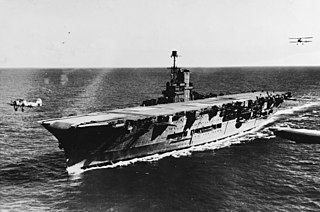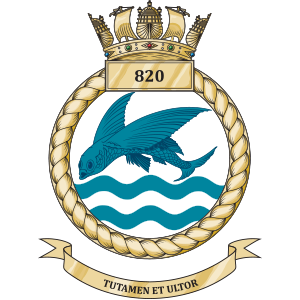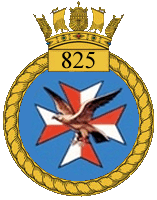
HMS Ark Royal was an aircraft carrier of the Royal Navy that was operated during the Second World War.

The Fairey Swordfish was a biplane torpedo bomber, designed by the Fairey Aviation Company. Originating in the early 1930s, the Swordfish, nicknamed "Stringbag", was principally operated by the Fleet Air Arm of the Royal Navy. It was also used by the Royal Air Force (RAF), as well as several overseas operators, including the Royal Canadian Air Force (RCAF) and the Royal Netherlands Navy. It was initially operated primarily as a fleet attack aircraft. During its later years, the Swordfish was increasingly used for anti-submarine and training duties. The type was in frontline service throughout the Second World War.

811 Naval Air Squadron was a unit of the British Royal Navy's Fleet Air Arm. It was first founded in 1933, and served during World War II, seeing action in the battle of the Atlantic and on Russian convoys, and was eventually disbanded in 1956.

816 Naval Air Squadron was a Fleet Air Arm (FAA) naval air squadron of the United Kingdom’s Royal Navy (RN) which formed at the start of the Second World War. It was first formed in March 1939, aboard the carrier HMS Furious, to support anti-submarine and strike missions for North Atlantic convoys. It conducted the first aerial torpedo attack of the war during the Norwegian Campaign in April 1940. An attack on the German battlecruiser Scharnhorst was attempted in September 1940, and on the squadron joined RAF Coastal Command in March 1941 for operations along the Dutch and French coasts. The squadron re-embarked on HMS Furious in June 1941 to provide anti-submarine cover while RAF aircraft were sent to Malta. On the return trip, it transferred to HMS Ark Royal and stayed with her until she sank in November 1941
John William Charlton Moffat was a Scottish Royal Navy Fleet Air Arm pilot, widely credited as the pilot whose torpedo crippled the German battleship Bismarck and author of the biographical I sank the Bismarck. Moffat took part in the courageous strike on the German battleship Bismarck during its Atlantic sortie, codenamed Operation Rheinübung, on 26 May 1941 whilst flying a Fairey Swordfish biplane.

820 Naval Air Squadron is a Royal Navy Fleet Air Arm carrier-based squadron flying the AgustaWestland Merlin HM2 in Anti-Submarine and Airborne Early Warning (AEW) roles from RNAS Culdrose.
821 Naval Air Squadron was a Royal Navy Fleet Air Arm carrier based squadron formed on 3 April 1933 with the transferral and amalgamation of the Fairey III aircraft from 446 and half of 455 Flight Flights Royal Air Force to the newly formed Fleet Air Arm of the Royal Air Force. The squadron operated during the Second World War.
810 Naval Air Squadron was a Royal Navy Fleet Air Arm carrier based squadron formed on 3 April 1933 with the amalgamation of the 12 Blackburn Dart aircraft from 463 and 44 Flight Flights Royal Air Force to the Fleet Air Arm. The squadron saw action during the Second World War, the Suez Crisis and the Korean War.

808 Naval Air Squadron is a ship-based helicopter squadron of the Royal Australian Navy.

814 Naval Air Squadron or 814 NAS, nicknamed the Flying Tigers, is a squadron of the Royal Navy Fleet Air Arm. It is currently equipped with the AgustaWestland Merlin HM2 anti-submarine warfare helicopter and is based at Royal Naval Air Station (RNAS) Culdrose in Cornwall. The squadron was formed in December 1938 and has been disbanded and reformed several times.

825 Naval Air Squadron is a Royal Navy Fleet Air Arm Naval Air Squadron which was re-commissioned on 10 October 2014 and currently flies the AgustaWestland Wildcat HMA2.

828 Naval Air Squadron was a Royal Navy Fleet Air Arm carrier based squadron formed in September 1940 as a torpedo spotter reconnaissance squadron. It operated in a number of the theatres of the Second World War, carrying out a number of attacks on enemy targets including the Tirpitz in Norway.

813 Naval Air Squadron, was a Fleet Air Arm (FAA) naval air squadron of the United Kingdom’s Royal Navy (RN) during World War II and again post-war. It initially operated Swordfish Mk Is from the aircraft carrier Illustrious and took part in the successful raid on Taranto in November 1940.
812 Naval Air Squadron was a Naval Air Squadron of the British Royal Navy's Fleet Air Arm. It was active between 1933 and 1956, and saw service in both World War II and the Korean War.
822 Naval Air Squadron was a Fleet Air Arm aircraft squadron before and during World War II.
823 Naval Air Squadron was a Fleet Air Arm aircraft squadron before and during World War II.

826 Naval Air Squadron was a Fleet Air Arm aircraft squadron formed during World War II which has been reformed several times since then until last disbanded in 1993.
Kenneth Pattisson was a Royal Navy Fleet Air Arm pilot credited by some with fatally crippling the German battleship Bismarck on 26 May 1941 whilst flying a Fairey Swordfish biplane. Pattisson was awarded the Distinguished Service Cross for his service during the war.

Royal Naval Air Station Twatt, is a former military airfield, located near Twatt, Orkney, Scotland, of the Royal Navy. It was built by the Admiralty and was commissioned on 1 April 1941. On 1 January 1942 it became an independent command as HMS Tern. The airbase was designed to provide accommodation for disembarked Front-Line squadrons and accommodation for disembarked Ship's Flight Aircraft and was home to the Home Fleet Fleet Requirements Unit, 771 Naval Air Squadron.











